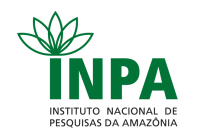Corpo Discente - Egressos
Rosângela do Socorro Ferreira Rodrigues Sarquis
| Título | Estudos multidisciplinares com espécies vegetais usadas tradicionalmente em uma comunidade ribeirinha na Amazônia. | ||||||||||||||||||||||||
| Data da Defesa | 28/02/2019 | ||||||||||||||||||||||||
| Download | Em sigilo | ||||||||||||||||||||||||
Banca
| |||||||||||||||||||||||||
| Palavras-Chaves | Conhecimento tradicional;Histoquímica;Amapá;Taxonomia Vegetal | ||||||||||||||||||||||||
| Resumo | Os habitantes da planície de inundação do rio Mazagão, estado do Amapá, Amazônia brasileira, herdaram das culturas indígenas, africanas e cabocla, as indicações de uso e as formas de preparação de plantas medicinais para a cura de suas doenças do corpo e do espírito. Este estudo teve como objetivo realizar um levantamento etnofarmacológico das plantas medicinais utilizadas pela comunidade ribeirinha das planícies de inundação do rio Mazagão. Neste optamos por entrevistas estruturadas com formulários socio-econômicos, etnofarmacológicos e etnobotanicos e um roteiro para entrevistas semiestruturadas. As coletas das plantas medicinais ocorreram durante visitas guiadas. O Valor de Uso (UV), o Fator de Consenso de Informantes (FCI), o Fator de Correção (FC) e o Nível de Fidelidade (FL) foram calculados. Houve 130 espécies de plantas medicinais, distribuídas em 116 gêneros e 57 famílias. Fabaceae (16), Lamiaceae (14), Euphorbiaceae (7) e Arecaceae (6), foram as famílias com 33,33% das espécies amostradas. Ao todo, foram citadas 95 espécies nativas; 33 são endêmicos das florestas de várzea, 62 são de florestas terrestres firmes e 35 são espécies não-nativas. As espécies com UVs mais altos (≥ 0,5) na foz do rio Mazagão foram Carapa guianensis (0,91), Pentachlethra macroloba (0,83), Dalbergia subcymosa (0,77), Uncaria tomentosa (0,75), Otacanthus azureus (0,62), Virola surinamensis (0,62), Hura crepitans (0,58), Euterpe oleracea (0,56) e Arrabidaea chica (0,51). Estes também foram os que apresentaram o maior FIC entre os informantes e 100% no FL para um uso terapêutico específico. O estudo compreendeu 16 categorias de uso terapêutico, das quais a maioria das plantas utilizadas estão relacionadas com doenças como as infecções microbianas (20,67%, 73 espécies), distúrbios gastrointestinais (13,31%) e inflamações (11,61%). Entre as espécies com utilização etnofarmacológica Otacanthus azureus (Linden) Ronse, foi altamente representativa no índice quantitativo como uma das espécies mais utilizadas, sendo citada como antimicrobiana, está foi selecionada para preparação de uma nano-emulsão com o seu óleo essencial e avaliar a influência de diferentes surfactantes na sua formação e estabilização, bem como avaliar a melhoria bioativa utilizando diferentes cepas bacterianas. As folhas e flores foram caracterizadas por microscopia eletrônica de varredura e o óleo essencial foi caracterizado por cromatografia gasosa acoplada a espectrometria de massas, revelando predominância de mono e sesquiterpenos. A nanoemulsão ideal foi obtida com o polissorbato 80 e não foi observado nenhum crescimento importante de gotas durante 30 dias de armazenamento. Uma interpretação profunda sobre a formação e estabilização deste sistema coloidal foi realizada, baseada nas propriedades físico-químicas in silico dos fitoquímicos. Uma notável melhoria da bioatividade induzida por esta nanoemulsão foi observada contra Staphylococcus aureus, Staphylococcus epidermidis e Salmonella typhi. Os resultados mostraram que o conhecimento sobre o uso de plantas medicinais ao longo dos rios e igarapés que formam a foz do rio Mazagão é uniformemente distribuído. Esta comunidade tem uma estreita relação com a floresta de várzea, pois fazem uso de 33 espécies endêmicas dessa floresta e trocam informações sobre o uso da flora medicinal local com a comunidade negra na cidade de Mazagão Velho, no município de Mazagão, Amapá, Brasil. | ||||||||||||||||||||||||
| Abstract | The riverside inhabitants of the Mazagão River floodplain in the State of Amapá in the Brazilian Amazon have important collections of plants used for therapeutic purposes. They inherited, from the indigenous African and caboclo cultures, the claims of use and the forms of preparation of medicinal plants for the cure of their diseases of the body and spirit. This study aimed to carry out an ethnobotanical and ethnopharmacological survey of the medicinal plant species used by the riparian residents of the Mazagão River floodplains. In this study, we opted for structured interviews with socio-economic, ethnopharmacological and ethnobotanical forms, and a script for semi-structured interviews and harvesting of medicinal plants that occurred during guided tours. The Use Value (UV), the Factor of Informants Consensus (FIC), and the Fidelity Level (FL) were calculated. There were 130 species of medicinal plants, distributed in 116 genera and 57 families. The families that had the greatest number of species were Fabaceae (16), Lamiaceae (14), Euphorbiaceae (7), Arecaceae (6), Asteraceae (4), Myrtaceae (4), Rubiacea (4), Rutaceae (4), Amaranthaceae (4), and Anacardiaceae (4). These totaled 52% of the species sampled. In all, 95 native species were cited; 33 are endemic to lowland forests, 62 are from firm ground forests, and 35 are non-native species. The species with the highest UVs (≥ 0.5) in the mouth of the Mazagão River were Carapa guianensis (0,91), Pentachlethra macroloba (0,83), Dalbergia subcymosa (0,77), Uncaria tomentosa (0,75), Otacanthus azureus (0,62), Virola surinamensis (0,62), Hura crepitans (0,58), Euterpe oleracea (0,56), and Arrabidaea chica (0,51). These were also the ones that presented the greatest FIC among informants and 100% in the FL for a specific therapeutic use. The study comprised 16 categories of therapeutic use, of which 73 species (56.6%) were related to use in microbial infections, 47 (36.4%) were referred for gastrointestinal diseases, and 41 were experiencing inflammation (31.7%). Among the species with ethnopharmacological use Otacanthus azureus (Linden) Ronse, was highly representative in the quantitative index as one of the most used species, being cited as antimicrobial, has been selected for study was to prepared a nano-emulsion with the essential oil from this species and evaluate the influence of different surfactants on its formation and stabilization, as well an evaluation of bioactive improvement using different bacteria strains. The leaves and flowers were characterized by scanning electron microscopy and the essential oil was characterized by gas-chromatography coupled to mass spectrometry, revealing a predominance of mono- and sesquiterpenes. Optimal nano-emulsion was achieved with polysorbate 80 and no major droplet growth was observed during 30 days of storage. A deep interpretation about formation and stabilization of this colloidal system was performed, based on in silico physicochemical properties of the phytochemicals. A remarkable improvement of bioactivity induced by this nano-emulsion was observed against Staphylococcus aureus, Staphylococcus epidermidis and Salmonella typhi. The results showed that knowledge about the use of medicinal plants along the rivers and streams that form the mouth of the Mazagão River is evenly distributed. This community has a close relationship with the lowland forest because they make use of 33 endemic species of this forest and exchange information about the use of the local medicinal flora with the community of black people in the town of Mazagão Velho in the municipality of Mazagão, Amapá, Brazil. | ||||||||||||||||||||||||
Parceiros

























